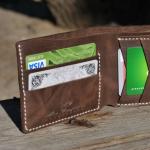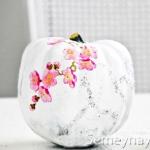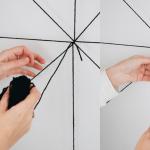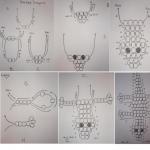The face of Santa Claus made of polymer clay. Do-it-yourself Santa Claus made of polymer clay
New Year is already so close ... and here is mine new year gift: master class on making cotton Santa Claus!
For work we need:
- flesh-colored polymer clay
- beads for eyes (or ready-made eyes)
- velvet (or any other beautiful fabric)
- acrylic paints
- contours on fabric
- plastic bottle
- Scotch
- glue gun
- foil
- wire
- starch.
Let's start by determining the size of our future grandfather. I needed a 50 cm tall grandfather, based on this I calculated the size of the head (you can find the proportions of the human body on the Internet). Let's start with the head!
We roll a dense ball out of foil, a little smaller than our future head and stick it on top with flesh-colored polymer clay:


If there are ready-made eyes, then it's great, if not, then we take suitable beads, like mine, and press them into place the peephole. If the layer of plastic on the foil ball was thin, then considerable force is required to press the beads into the foil.

If you, like me, use beads instead of eyes, then perhaps at this stage you can paint them white, which I did not do and which I regretted later.

Let's start sculpting the face! Do not think that this is so difficult ... personally, I also had my first face, the main thing here is to make the eyes and nose look good, the rest is successfully hidden under the mustache, eyebrows and beard of my grandfather. I will show step by step photos how I did it:










Here's a little face I got. As you can see from the last photo, the shape of the head is not round ... more like just a face, but this is not critical! We, in fact, needed the face itself, the rest will later be supplemented with cotton wool. I'm sending my face to bake!

After baking, we tint the nose and cheeks of our grandfather to get a blush and draw the eyes:

It was then that I realized that the whites of the eyes had to be painted over in advance ... it was quite difficult to paint over them without splashing the eyelids with white paint.
Cover the finished face with plastic varnish. Let me remind you that products made of polymer clay (plastic) can be coated ONLY with a special varnish !!! If this is not the case, then it is better to leave it uncovered, because not all varnishes are suitable for these purposes. An unsuitable varnish may simply not dry on the plastic, or it may begin to stick for a while and the whole work will be ruined!

Now you need to make a blank for the rest of the grandfather, i.e. his body. For this we need plastic bottle and scotch!

My bottle turned out to be quite soft and easily deformed, and it was too small in "growth", so I strengthened it by wrapping it in several layers with scotch tape, and put it on top with crumpled newspaper to the desired "growth", also securing it with tape!

But the head turned out to be quite heavy, and the body structure was very light, so I decided to make the bottom heavier. This could have been done by filling a bottle with something, but in my case it was too late to do so, because I've already wrapped it all with duct tape. So I went the other way ... I put glass stones between the layers of tape (I didn't find anything else, although I could have used something less scarce) and again wrapped everything with tape:

This is about the kind of blank you should get.

Now we attach the head. We drill a hole in the head (by the way! The hole for the fastening stick could also have been made in advance, even before baking) and glue the fastening stick, and then we glue it all into our workpiece. I have a newspaper on top of it, so the stick went in easily enough:



The blank for Santa Claus is ready! Now for the fun part! We begin to sculpt it from cotton wool.
It is better to take cotton wool in rolls and of good quality, then it unwinds well and is easy to cut and much easier to work with.
Cooking "jelly". We dilute a tablespoon of starch in a small amount of cold water and pour a glass of boiling water, stirring vigorously. The paste should be free of lumps.

We cut off a layer of cotton wool (cotton wool can be cut like a fabric) and spread it with "jelly" on both sides, and then we wrap our grandfather like a mummy.

Do not try to make the fur coat even and beautiful the first time. We will have several layers of cotton, each of which needs to be thoroughly dried. After the starch paste dries, a crust forms on the surface of the cotton wool or something like that, and the cotton wool inside will remain soft and fluffy! This is the beauty of cotton toys By the way ... before you start working with cotton wool and paste, take care of the presence of water nearby. It may be a sink with a tap, or it may just be a basin of water and a towel. with each new piece of cotton wool, you can only work with clean hands.

We make a cotton cap for our mummy, for one and leveling the shape of the skull, we sculpt the eyebrows (although they can be done later). From above, you can once again coat the workpiece with "jelly". Cotton wool should be well missed! ... and this is what we should get:



Trying on ...

We put our mummy to dry, we hang our hands separately so that they do not touch unnecessary objects, otherwise they will dry out.

As the workpiece has dried, you can cover it with another layer of cotton wool (this also touches your hands), until you reach the desired volume of the fur coat. Try to make the last layer of cotton as even as possible, I did it well by gluing the strips of cotton vertically, and not wrapping horizontally, as before. Here is my final result after drying:

If the cotton wool does not adhere well, then you can fix it with threads, I did it on my hands, for reliability, thereby I edited the shape of the hands.
Well ... you can start covering the fur coat with velvet. I do this with a glue gun. We cut out a fur coat and fit our blank:

According to my idea, the floors of the fur coat should diverge a little at the bottom, so I made an insert of silver brocade, which will look out from under the fur coat.

We also wrap our hands with velvet:

At this stage, I paint the mittens with silver paint. Let's example.

Now you need to refine the bottom. Cut out a circle of a suitable diameter from cardboard and cover it with fabric.

We glue the bottom, and for reliability I also sewed it on:

Moving on to finishing the fur coat.
We cut out strips of cotton wool of the required size, coat them with paste as before and glue them to the fur coat:



We trim the sleeves and use a glue gun to fasten our hands in place.

We cut out a collar and put it on a fur coat:


Klim your beard in the same way.

To make it more textured, I make separate strands of cotton wool and add to the beard:







Everything! You can dry your grandfather!

After the grandfather is dry, I fix the blemishes and decorate it. In some places, the cotton wool could not adhere well to the velvet, I glue it with hot glue from a gun. I add a belt and paint the fur coat using acrylic outlines for the fabric (although I think any outlines will work):

I made the staff according to the same principle as my grandfather ... wrapped the stick with cotton, dried it and painted it with silver paint, like the mittens:

Decorated it with a silver outline, crystal paste (like ice) and an openwork metal bead!





And here he is, handsome, Morozko, ready to meet with us New Year!

Each of us has our favorite fairytale heroes. They make us smile, giving moments of joy and immersing ourselves in the happiest memories. One of these characters - of course! So familiar to all children and adults, with a snow-white beard and red nose.
December is not just a calendar milestone, it is a month when we have the opportunity to become magicians and realize our wildest dreams.
A funny, touching, and very kind Santa Claus can be made your own with my own hands... Get great pleasure from this and give a lot of joy to those who receive it as a gift.
Do you think making such figures out of polymer clay is too difficult and difficult? But let's try to do modeling?
Modeling from polymer clay very easy to master, even for those who have never handled this material. You can just remember how to sculpt from plasticine. Thin and thick layers, sausages, balls - these are the main parts from which you can get anything. A few additional movements and the ball turns into a drop, and the drop into a cap or sleeve. The same ball can be easily turned into a nose or eye pupil, and a sausage - into a fur edge.
Let's start creating?
Discussion of the article
With great joy and a reliable one that will come in handy, master classes from the Internet, she herself has already managed to make a wreath and a poinsentia, it turns out great, and not difficult.
I suggest you make an interesting amulet as a gift for the New Year - a snake with a Christmas tree. As you know, the symbol of the new 2013 is just a snake, but not a simple one, but a water one. Therefore, we will make our snake a light blue color.
Prepare polymer clay in green, brown (for the crown and trunk of the tree), blue (for the snake itself), red, orange, yellow (for making balls on the tree), white and black (for the eyes of the snake). You will also need a blade for slicing plastic, a toothpick as a base for a Christmas tree and varnish for plastic products.
Let's start by making a Christmas tree. We take a piece of green plastic and cut it into 4 unequal parts - one is the largest, the rest are smaller. 
We roll each piece of plastic into a ball, flatten it a little and start pressing the edges with our fingers to make a skirt around the perimeter. We do the same with all four pieces. Pull the smallest up a little. 
We assemble the tree by sticking pieces one on top of the other, starting with the largest one. The crown of our tree is ready! Now let's make the trunk. 
We sculpt a small stump from brown plastic and stick a toothpick into it. We hit the green part of the tree on top of a toothpick. If the size of the toothpick is longer than the tree, then just cut it to the desired length in advance.
Now let's make the snake itself. We take a piece of blue plastic and cut it in half - one piece on the head, the second on the body.
We roll out a long sausage so that it narrows at one end and wrap the Christmas tree around it in a circle. We make the tail with a curl.
We sculpt the head - we form an oval from plastic and with the help of a toothpick or a needle we draw the line of the mouth. We fasten the head to the body of the snake, pressing it well. 



We form two balls from white plastic - these will be the eyes of our snake. Make small pupils out of black and attach everything to the snake's head. If you have ready-made doll eyes, you can use them, but glue them only after the snake is baked in the oven, otherwise the eyes will melt. 

The only thing we are missing is the decorations on the tree! Sculpt christmas balls from orange, yellow and red plastic and sculpt to the tree 
It remains to bake the toy in the oven and varnish. To properly bake the product - follow the instructions of the plastic manufacturer. Cover with one coat of varnish, carefully smearing the space between the layers of the tree. 
Polymer clay modeling is an interesting and exciting activity that will appeal to both children and adults. I bring to your attention a very simple and detailed master class for sculpting Santa Claus, which can be presented as a souvenir or used for New Year's decor to a small Christmas tree.
To complete Santa Claus you will need:
Polymer clay of various colors;
- A small piece of food foil;
- Plastic board for modeling;
- Special tools for sculpting: stacks, bulks with balls at the end of different diameters, a knife, a thin rolling pin.
1.
Mash the polymer clay and prepare the balls, observing their proportions, as in the photo.
2.
Roll a tight ball out of foil. Roll out green polymer clay into a thin layer and stick it with a ball of foil - this will be the body of Santa Claus.
3.
Stick a red beanie ball to your body.
4.
Form a hat by stretching out a red ball with a cone, polymer clay at the junction (hat to the body) tightly blind together.
5.
Place the workpiece on a flat surface and gently roll with your fingers, giving the workpiece an elongated shape.

6.
Roll the beige ball into a thin round cake and stick to the blank - this will be the face.
7.
Polymer clay white roll a thin sausage, roll it up with the letter "C" and flatten it a little - this will be a beard.
8-9.
Gently stick the beard to the workpiece, press a relief on it with a thin flat stack and form an uneven edge.
10-11.
Roll up the thinner mustache sausage, shape it and cut it in half with the blade. Stick the mustache to the workpiece and emboss it using the same flat and thin stack.

12.
Form a spout from a small beige sausage, stick it to the face, smooth the joints with a bullet with a small ball and make them as invisible as possible. Sculpt small beady eyes from black polymer clay. Roll out the white polymer clay into a thin layer, cut a thin long strip with a blade, and stick it along the bottom edge of the cap.
13.
Give the white edging strip a relief with bulbs and stacks. Use a small white ball to shape a bubo for a hat.
14.
Roll sausages for pens from green polymer clay, bend them at the elbows and stick small beige polymer clay balls for palms. Stick the handles to the body, gently align the joints on the shoulder with a bulka with a large ball.
15.
For the stability of Santa Claus, mold from polymer clay Brown legs and stick them to the body.

Bake the completed Santa Claus in the oven (observe the temperature and baking time exactly according to the instructions on the package from your polymer clay).
With great joy and a reliable one that will come in handy, master classes from the Internet, she herself has already managed to make a wreath and a poinsentia, it turns out great, and not difficult.
I suggest you make an interesting amulet as a gift for the New Year - a snake with a Christmas tree. As you know, the symbol of the new 2013 is just a snake, but not a simple one, but a water one. Therefore, we will make our snake a light blue color.
Prepare polymer clay in green, brown (for the crown and trunk of the tree), blue (for the snake itself), red, orange, yellow (for making balls on the tree), white and black (for the eyes of the snake). You will also need a blade for slicing plastic, a toothpick as a base for a Christmas tree and varnish for plastic products.
Let's start by making a Christmas tree. We take a piece of green plastic and cut it into 4 unequal parts - one is the largest, the rest are smaller. 
We roll each piece of plastic into a ball, flatten it a little and start pressing the edges with our fingers to make a skirt around the perimeter. We do the same with all four pieces. Pull the smallest up a little. 
We assemble the tree by sticking pieces one on top of the other, starting with the largest one. The crown of our tree is ready! Now let's make the trunk. 
We sculpt a small stump from brown plastic and stick a toothpick into it. We hit the green part of the tree on top of a toothpick. If the size of the toothpick is longer than the tree, then just cut it to the desired length in advance.
Now let's make the snake itself. We take a piece of blue plastic and cut it in half - one piece on the head, the second on the body.
We roll out a long sausage so that it narrows at one end and wrap the Christmas tree around it in a circle. We make the tail with a curl.
We sculpt the head - we form an oval from plastic and with the help of a toothpick or a needle we draw the line of the mouth. We fasten the head to the body of the snake, pressing it well. 



We form two balls from white plastic - these will be the eyes of our snake. Make small pupils out of black and attach everything to the snake's head. If you have ready-made doll eyes, you can use them, but glue them only after the snake is baked in the oven, otherwise the eyes will melt. 

The only thing we are missing is the decorations on the tree! We sculpt Christmas balls from orange, yellow and red plastic and we sculpt them to the Christmas tree 
It remains to bake the toy in the oven and varnish. To properly bake the product - follow the instructions of the plastic manufacturer. Cover with one coat of varnish, carefully smearing the space between the layers of the tree. 





